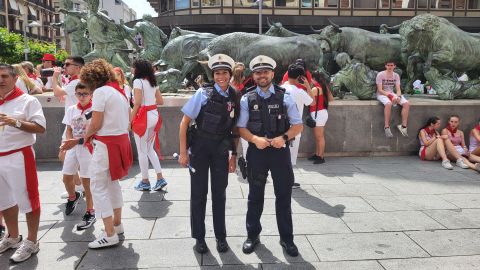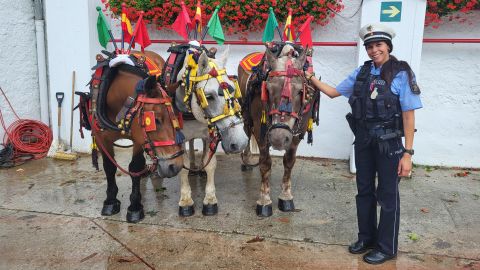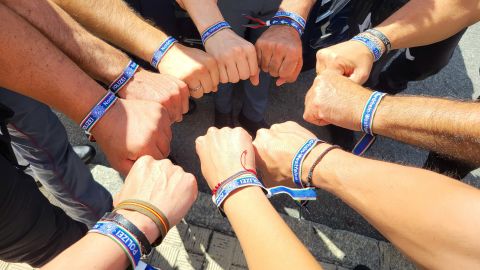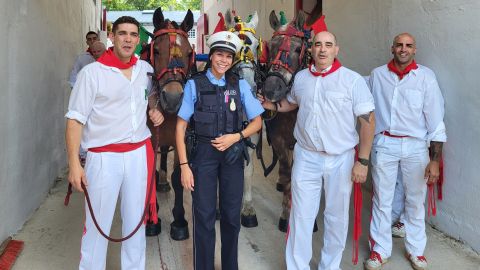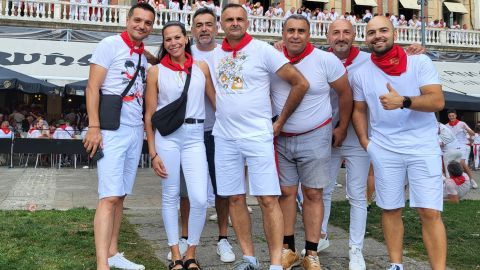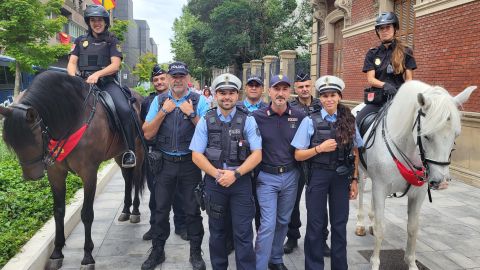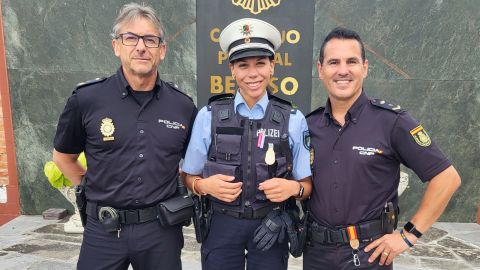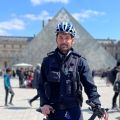I first became aware of the "European Commissariats" project in Spain through an article on the North Rhine-Westphalia police intranet at the end of 2022. I read the call for applications from the NRW Ministry of the Interior with great interest and immediately knew that, as a child of German-Dominican parents, I had to make the most of this opportunity.
Being close to my Latin American roots has always been very important to me and being able to realize this as a police officer in Spain was a chance for me to have a completely new life and service experience and fulfill a previously unfulfilled dream!
I therefore didn't hesitate for a second to apply for the project and after an interview in Düsseldorf, I received the good news: I had been accepted to support the Policía Nacional during the "Sanfermines" in Pamplona, Spain!
But where is Pamplona? And what are the "Sanfermines" anyway?
Pamplona is located in the north of Spain and is the capital of the province of Navarra. The city of around 200,000 inhabitants is known as one of the main stops on the Way of St. James and for the "Sanfermines" bull runs that take place in July.
The Sanfermines are one of the most famous popular festivals in Spain and take place in Pamplona every year from July 6 to 14. During this period, so-called "bull runs (encierros)" take place daily through the streets of Pamplona, with daredevils running ahead of the free-running bulls. Later in the day, the bullfights (las corridas de toros) take place within the "Plaza de Toros" of Pamplona.
On this occasion, the entire city is decorated in white and red and celebrations take place at all times of the day and night. The spectacle surrounding the running of the bulls attracts several thousand visitors and many tourists to Pamplona every year, which requires a large number of police officers.
Day of arrival
The day before the start of the festivities, I finally set off. I flew from Düsseldorf to Bilbao and met my colleague Tobias at the airport in Germany, with whom I would be traveling for the NRW police.
The flight, with my weapon and uniform in my luggage, went smoothly. When we arrived in Bilbao, we were met by a colleague from the Policía Nacional, who took us to the hotel in the center of Pamplona, about 1.5 hours away.
On arrival at the hotel and after checking in, we finally met the rest of our international "police force". In total, we were eight European police officers supporting the Policía Nacional during the festive period as part of the "European Commissariats" program in Pamplona: two officers each from France, Italy, Portugal and Germany. We exchanged ideas and got to know each other and it quickly became clear that the chemistry between us was right! We all felt a huge sense of anticipation about what to expect over the next few days.
But not only we, as international police officers, were accommodated in the "Residencia", but also numerous police officers from Germany who had traveled from all over Spain for the Sanfermines festivities and whose acquaintance we made during our stay in Pamplona. Among them were Spanish colleagues from the riot police, the equestrian squadron, civilian forces and even drone pilots from the Policía Nacional. In view of the expected high number of visitors and tourists, the Spanish police and the city of Pamplona had apparently prepared themselves well for the coming festive season.
"Viva San Fermín!" - "Long live San Fermín!"
On July 6, we finally got started. We were warmly welcomed that morning before the festivities by the three colleagues from the Policía Nacional who were to accompany us over the next few days. The warmth and hospitality of Guini, Roberto and David could not be surpassed. In the days that followed, they did everything they could to ensure that we had an interesting and informative assignment and a good stay in Pamplona in general.
Our first assignment was at the "Jefatura Superior de Policía Nacional" in Pamplona, which is like a police headquarters. There we, the European police officers, were welcomed by the "Jefe Superior", the Chief of Police of the Navarra region. I was impressed by the calm yet serious manner in which he welcomed us and thanked us for our presence. The city was now full of people, the celebrations were due to start in just under two hours and there was no sign of nervousness in the Jefe Superior. Instead, he had a friendly chat with us. We were then given a tour of the other directorates of the Jefatura Superior, including the "Comisaría", the central police station in Pamplona.
Finally, it was time to occupy the police van ("Furgoneta") and get stuck into the action. The city no longer resembled the city of the day before and had come to life. There were euphoric groups of people everywhere and music parades were taking place in the streets. Without exception, the people in the city were traditionally dressed in white and red and were in a great party mood. Incidentally, this continued for the entire duration of the Sanfermines.
We headed for the pedestrian zones and popular squares with a high volume of visitors and tourists in order to show police presence as part of our foot patrols and to be available to locals and tourists as a point of contact. We also distributed flyers and wristbands for the children, on which the parents' availability was noted.
The response from the public to our presence was consistently positive. People were curious to know where we were from and what foreign police officers were doing in Pamplona. Others wanted to take photos with us or simply let us know that they thought our work was commendable. The interest, friendliness and gratitude of the locals and tourists was remarkable and only reinforced my belief that - even though the number of German tourists in Pamplona was rather low - I was in the right place.
But there was also a lot of interest from the press and media. On the opening day of the Sanfermines, a television interview with the well-known Spanish television station "RTVE" awaited us. This was broadcast as part of a report on the Sanfermines. Other press teams also accompanied us on the other days and reported on our stay in Pamplona and the international "European Commissariats" project in newspaper and Internet articles.
The rest of our day-to-day work
In the days that followed, we mainly worked early or late shifts. We were usually picked up at our accommodation by our Spanish colleagues and started our shift at the "Acuartelamiento de la Policía Nacional", a kind of police barracks of the Policía Nacional.
This was followed by daily foot patrols at popular tourist locations. During these patrols, we also got to know other police authorities in Spain and were always in contact with our colleagues. We also visited numerous hotels, where we distributed flyers and informed them about the presence of international police officers.
One of my personal highlights on the job was when we were also allowed to ensure that visitors felt safe inside the "Plaza de Toros", the bullring. We were allowed to go behind the scenes of the arena and watch the bullfighting action. I have never seen anything like it in my life and was overwhelmed by the impressions of the bullring and the atmosphere in the auditorium!
Time to say "Adiós" - "Goodbye"!
I have to admit, before I traveled to Pamplona, I could only partially understand the fuss surrounding the Sanfermines celebrations with the associated bull races and bullfights. However, my stay there showed me that the Sanfermines are so much more: The cheerfulness of the people, the music and dancing, the culture as well as the wonderful customs, make the festival something very special. Over time, I was able to understand why the Spanish love this tradition so much.
In conclusion, the Sanfermines celebrations were a complete success again this year. Thanks to the seamless cooperation of the police and other authorities, everything went smoothly and peacefully. Everything and everyone was thought of and I was also able to play my part - thanks to the European Commissariats project!
The nine days that the Sanfermines lasted went by very quickly for me. And yet it was a very eventful time, with many experiences that I will never forget and that are very valuable to me both professionally and privately. I also grew very fond of the great people who accompanied me on this unique experience in such a short time.
I would like to take this opportunity to thank the Policía Nacional, the NRW Ministry of the Interior and the KPB Rein-Sieg-Kreis for making it possible for me to take part in the project and have such a great experience. It was an honor for me!
